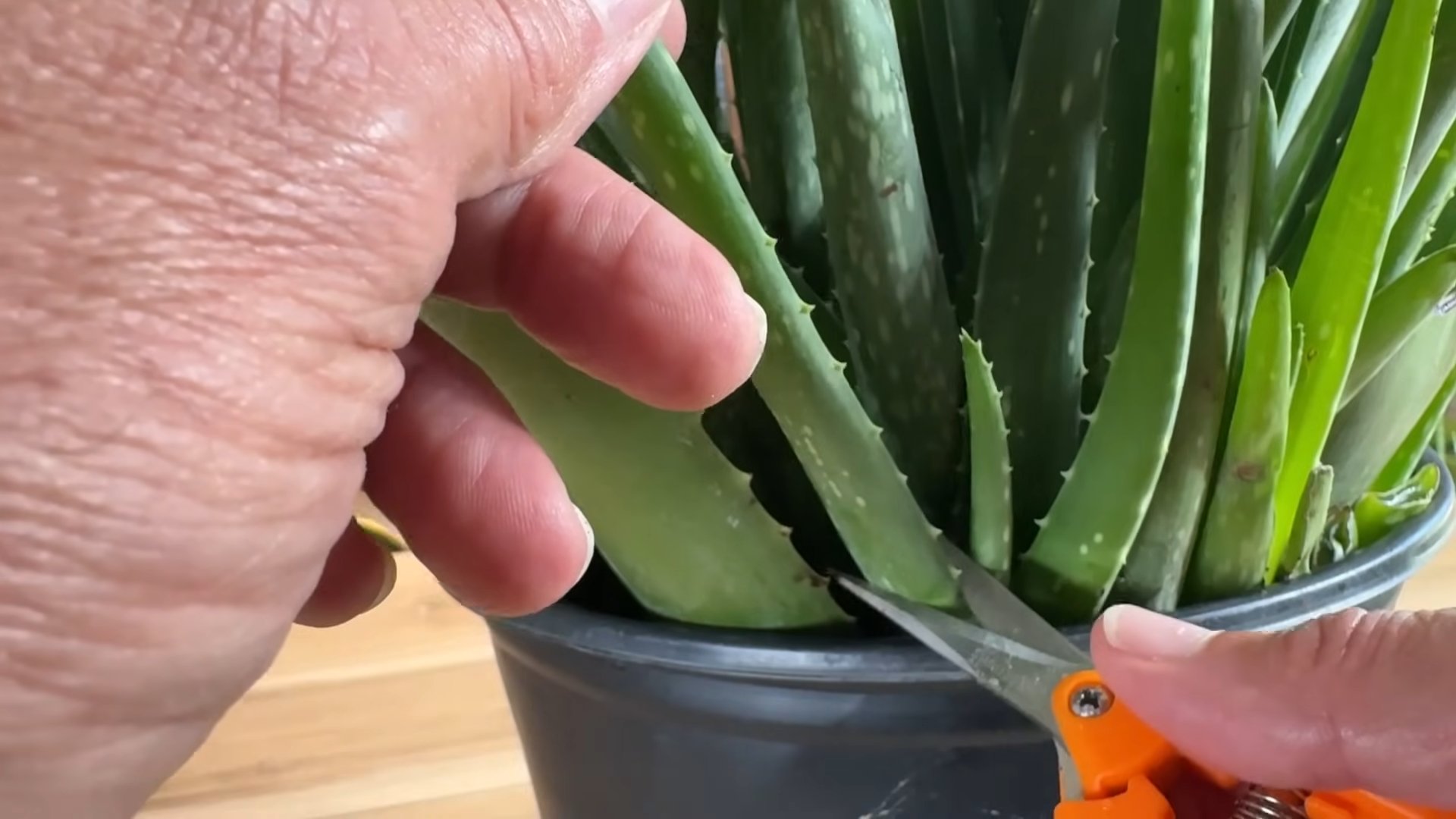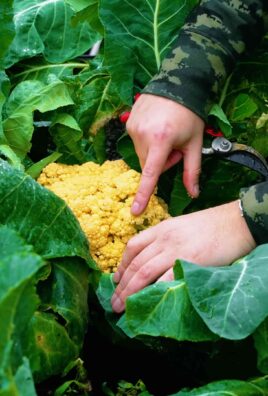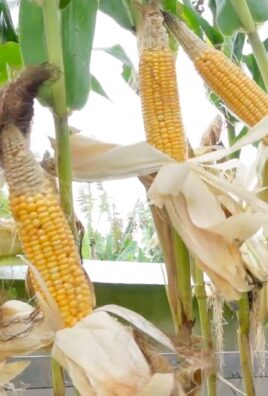Grow aloe vera from leaf? Absolutely! Imagine effortlessly propagating new aloe vera plants from just a single leaf, expanding your collection and enjoying the soothing benefits of this amazing succulent. It’s easier than you think, and I’m here to guide you through every step of the process.
Aloe vera has a rich history, dating back thousands of years. Ancient Egyptians referred to it as the “plant of immortality,” using it for its medicinal properties and beauty treatments. Cleopatra herself was rumored to use aloe vera in her skincare routine! This incredible plant has been cherished across cultures for its healing and soothing abilities, and now you can easily cultivate your own supply.
Why would you want to learn this DIY trick? Well, aloe vera is a fantastic addition to any home. Its gel is a natural remedy for sunburns, minor cuts, and skin irritations. Plus, it’s a low-maintenance plant that thrives indoors, adding a touch of greenery to your living space. Learning to grow aloe vera from leaf allows you to propagate new plants without spending a fortune on new ones. It’s a cost-effective and rewarding way to expand your indoor garden and always have a natural remedy on hand. Let’s dive in and discover the secrets to successful aloe vera propagation!

Growing Aloe Vera from a Leaf: A DIY Guide
Hey there, plant enthusiasts! Ever wondered if you could magically sprout a whole new aloe vera plant from just a single leaf? Well, while it’s not exactly magic, it’s definitely possible, and I’m here to guide you through the process. It’s a bit of a waiting game, and success isn’t guaranteed every time, but the thrill of potentially creating a new plant from scratch is totally worth it!
Understanding Aloe Propagation
Before we dive in, let’s be clear: growing aloe from a leaf cutting is a bit different than propagating other succulents. Aloe vera doesn’t always root as easily from a leaf as, say, a succulent like a sedum. The leaf cutting method is more about encouraging the development of “pups” (baby aloe plants) at the base of the leaf. These pups will have their own root systems, and that’s what we’re aiming for.
Important Considerations:
* Leaf Selection: Choose a healthy, mature leaf from a well-established aloe vera plant. The plumper and more robust the leaf, the better your chances of success. Avoid leaves that are damaged, discolored, or showing signs of disease.
* Patience is Key: This process takes time – weeks, even months. Don’t get discouraged if you don’t see results immediately.
* Not Always Successful: Be prepared for the possibility that your leaf cutting might not produce pups. It’s all part of the learning experience!
Materials You’ll Need
* A healthy aloe vera leaf
* A clean, sharp knife or scissors
* Rooting hormone powder (optional, but recommended)
* A small pot or container with drainage holes
* Well-draining potting mix (cactus or succulent mix is ideal)
* Watering can or spray bottle
* A bright, indirect light source
Step-by-Step Instructions
Okay, let’s get our hands dirty! Here’s how to propagate aloe vera from a leaf cutting:
1. Selecting and Cutting the Leaf:
* Carefully inspect your aloe vera plant and choose a healthy, mature leaf. Look for one that’s near the base of the plant and feels firm.
* Using a clean, sharp knife or scissors, make a clean cut at the base of the leaf, as close to the stem as possible. A clean cut minimizes the risk of infection.
* Try to avoid tearing the leaf. A clean cut is crucial for successful rooting.
2. Callousing the Cut End:
* This is a super important step! After cutting the leaf, you need to let the cut end callous over. This prevents rot and encourages root formation.
* Place the leaf cutting in a dry, shaded area for about 1-3 days. You’ll notice the cut end will start to dry out and form a protective layer.
* The callousing process is essential for preventing fungal infections and promoting root growth.
3. Applying Rooting Hormone (Optional):
* While not strictly necessary, rooting hormone can significantly increase your chances of success.
* Dip the calloused end of the leaf cutting into rooting hormone powder. Make sure to coat the entire cut surface.
* Rooting hormone contains auxins, which are plant hormones that stimulate root development.
4. Preparing the Potting Mix:
* Aloe vera needs well-draining soil to thrive. Cactus or succulent potting mix is perfect because it allows excess water to drain away quickly.
* Fill a small pot or container with the potting mix, leaving about an inch of space at the top.
* Make sure the pot has drainage holes to prevent waterlogging.
5. Planting the Leaf Cutting:
* Moisten the potting mix slightly. It should be damp but not soggy.
* Insert the calloused end of the leaf cutting into the potting mix, burying it about 1-2 inches deep.
* Gently pack the soil around the base of the leaf to provide support.
* Don’t plant the leaf too deep, as this can increase the risk of rot.
6. Providing the Right Environment:
* Place the pot in a location with bright, indirect light. Avoid direct sunlight, which can scorch the leaf.
* Aloe vera prefers warm temperatures, so keep it in a room that’s consistently between 65-80°F (18-27°C).
* Avoid placing the pot near drafts or extreme temperature fluctuations.
7. Watering and Maintenance:
* Water sparingly! Aloe vera is a succulent and doesn’t need a lot of water.
* Allow the soil to dry out completely between waterings. When you do water, water thoroughly until water drains out of the drainage holes.
* Overwatering is a common mistake that can lead to rot.
* Check the soil moisture regularly by sticking your finger into the soil. If it feels dry, it’s time to water.
8. Waiting for Pups to Appear:
* Now comes the hard part: waiting! It can take several weeks or even months for pups to start appearing at the base of the leaf cutting.
* Be patient and continue to provide the right environment.
* You might notice small, green shoots emerging from the soil near the base of the leaf. These are the pups!
9. Separating the Pups (Optional):
* Once the pups have developed a few leaves and their own root systems, you can carefully separate them from the mother leaf.
* Gently dig up the entire plant and carefully separate the pups, making sure to keep as much of their root systems intact as possible.
* Plant each pup in its own small pot with well-draining potting mix.
10. Caring for the New Aloe Plants:
* Treat the new aloe plants just like you would any other aloe vera plant.
* Provide them with bright, indirect light, well-draining soil, and water sparingly.
* With proper care, your new aloe plants will thrive and grow into healthy, mature plants.
Troubleshooting
Even with the best intentions, things don’t always go as planned. Here are some common problems you might encounter and how to address them:
* Leaf Rotting: This is usually caused by overwatering. Make sure the soil is well-draining and allow it to dry out completely between waterings. If the leaf is rotting, remove it immediately to prevent the rot from spreading.
* No Root Growth: Sometimes, the leaf cutting just won’t root. This could be due to a number of factors, such as poor leaf selection, improper callousing, or unfavorable environmental conditions. Try again with a different leaf and make sure to follow the steps carefully.
* Pests: Aloe vera can be susceptible to pests like mealybugs and scale. Inspect your plants regularly and treat any infestations promptly.
* Yellowing Leaves: Yellowing leaves can be a sign of overwatering, underwatering, or nutrient deficiency. Adjust your watering schedule and consider fertilizing with a balanced fertilizer.
Tips for Success
* Use a sterile knife or scissors: This will help prevent infection.
* Don’t overwater: Aloe vera is very susceptible to root rot.
* Provide bright, indirect light: Avoid direct sunlight, which can burn the leaves.
* Be patient: It can take several weeks or even months for pups to appear.
* Experiment: Don’t be afraid to try different techniques and see what works best for you.
Alternative Method: Water Propagation (Use with Caution)
While soil propagation is generally recommended, some people have had success with water propagation. However, it’s important to note that aloe vera is prone to rotting in water, so this method requires extra care.
1. Callous the Leaf: Follow the same steps as above to callous the cut end of the leaf.
2. Prepare a Container: Fill a glass or jar with water.
3. Submerge the End: Place the calloused end of the leaf in the water, making sure only the very tip is submerged.
4. Change the Water Regularly: Change the water every 1-2 days to prevent bacteria growth.
5. Monitor for Roots: Keep an eye out for root development. This can take several weeks.
6. Plant in Soil: Once roots have formed, carefully plant the leaf in well-draining potting mix.
Important Note: Water propagation can be risky for aloe vera. If you notice any signs of rot, remove the leaf from the water immediately and try soil propagation instead.
Final Thoughts
Growing aloe vera from a leaf is a rewarding experience that allows you to expand your plant collection and learn more about plant propagation. While it’s not always successful, the potential to create

Conclusion
So, there you have it! Growing aloe vera from a single leaf might seem like a botanical magic trick, but it’s a surprisingly accessible and rewarding project for any plant enthusiast, regardless of experience level. We’ve walked you through the process, from selecting the perfect leaf to nurturing your new aloe vera plant. But why should you embark on this green adventure?
Firstly, it’s incredibly cost-effective. Instead of purchasing a mature aloe vera plant, you can propagate multiple plants from just one healthy leaf. This is especially beneficial if you’re looking to expand your collection or share the gift of aloe with friends and family. Think of all the soothing aloe vera gel you’ll have access to for sunburns, minor cuts, and even as a natural ingredient in your skincare routine!
Secondly, it’s a deeply satisfying experience. Witnessing the miracle of life unfold as roots emerge from a seemingly lifeless leaf is truly captivating. It connects you to the natural world in a tangible way and fosters a sense of accomplishment. Plus, you’ll gain a deeper understanding of plant propagation techniques, which can be applied to other succulents and plants in your garden.
Thirdly, growing aloe vera from a leaf allows you to control the quality and health of your plants from the very beginning. You can ensure they are grown in optimal conditions, free from pests and diseases, and nurtured with the right nutrients. This is particularly important if you plan to use the aloe vera gel for medicinal or cosmetic purposes.
But the benefits don’t stop there! Consider these variations to personalize your aloe vera propagation journey:
* Experiment with different types of aloe vera: There are hundreds of aloe vera varieties, each with its unique characteristics. Try propagating different types to create a diverse collection.
* Use different rooting mediums: While we recommend a well-draining succulent mix, you can also experiment with other mediums like perlite, vermiculite, or even water propagation.
* Create a miniature aloe vera garden: Once your propagated aloe vera plants have established themselves, transplant them into a decorative container to create a charming miniature garden.
* Gift your propagated aloe vera plants: Share the joy of growing aloe vera with friends and family by gifting them your successfully propagated plants.
Remember, patience is key. It may take several weeks or even months for roots to develop. Don’t be discouraged if your first attempt isn’t successful. Keep experimenting, learning, and refining your technique.
We wholeheartedly encourage you to try growing aloe vera from a leaf. It’s a fun, rewarding, and sustainable way to expand your plant collection and enjoy the many benefits of this amazing succulent. So, grab a healthy leaf, follow our guide, and prepare to be amazed!
And most importantly, we want to hear about your experience! Share your photos, tips, and challenges in the comments below. Let’s create a community of aloe vera enthusiasts and learn from each other. Happy growing!
Frequently Asked Questions (FAQ)
1. What kind of aloe vera leaf should I use for propagation?
The best leaves for propagation are mature, healthy leaves from a well-established aloe vera plant. Look for leaves that are plump, firm, and free from blemishes, spots, or signs of disease. Avoid using leaves that are damaged, dried out, or too young. The ideal leaf should be at least 4-6 inches long to provide enough energy for root development. It’s also best to take leaves from the lower part of the plant, as these tend to be more mature.
2. How long does it take for aloe vera roots to grow from a leaf?
Rooting time can vary depending on several factors, including the type of aloe vera, the environmental conditions (temperature, humidity, light), and the rooting medium used. Generally, it can take anywhere from 4 to 8 weeks for roots to start developing. Be patient and avoid disturbing the leaf too often. Check for root growth by gently tugging on the leaf. If you feel resistance, it means roots have started to form.
3. What is the best soil mix for growing aloe vera from a leaf?
Aloe vera thrives in well-draining soil. A succulent or cactus mix is ideal, as it provides the necessary drainage to prevent root rot. You can also create your own mix by combining equal parts of potting soil, coarse sand, and perlite. Avoid using heavy, clay-based soils, as they retain too much moisture and can lead to root problems. Ensure the pot you use has drainage holes to allow excess water to escape.
4. How often should I water the aloe vera leaf during propagation?
Water sparingly during the propagation process. Overwatering is a common mistake that can lead to rot. Allow the soil to dry out completely between waterings. When you do water, moisten the soil lightly, but avoid getting the leaf wet. Once roots have developed, you can gradually increase the watering frequency, but always allow the soil to dry out between waterings.
5. What kind of light does the aloe vera leaf need during propagation?
Aloe vera leaves need bright, indirect light during propagation. Avoid placing them in direct sunlight, as this can scorch the leaves. A location near an east- or west-facing window is ideal. If you don’t have access to natural light, you can use a grow light to provide supplemental lighting. Once roots have developed and the plant is established, you can gradually acclimate it to more direct sunlight.
6. My aloe vera leaf is turning brown or yellow. What should I do?
Browning or yellowing of the aloe vera leaf can be caused by several factors, including overwatering, underwatering, sunburn, or fungal infection. If the leaf is mushy and brown, it’s likely due to overwatering and root rot. In this case, remove the affected leaf and allow the soil to dry out completely before watering again. If the leaf is dry and yellow, it may be due to underwatering or sunburn. Adjust your watering schedule and move the plant to a location with less direct sunlight. If you suspect a fungal infection, treat the plant with a fungicide.
7. Can I propagate aloe vera from a leaf cutting in water?
While it’s possible to propagate aloe vera from a leaf cutting in water, it’s generally not the preferred method. Aloe vera leaves are prone to rotting in water, so it’s important to take precautions. If you choose to propagate in water, use a clean glass or jar and fill it with just enough water to cover the cut end of the leaf. Change the water every few days to prevent bacterial growth. Once roots have developed, transplant the leaf into a well-draining soil mix.
8. How do I know when the aloe vera plant is ready to be transplanted?
The aloe vera plant is ready to be transplanted when it has developed a healthy root system and new growth is visible. This typically takes several weeks or months. Gently tug on the leaf to check for resistance. If you feel resistance, it means roots have started to form. You can also carefully remove the plant from its container to inspect the roots. If the roots are circling the bottom of the container, it’s time to transplant it into a larger pot.
9. Can I use rooting hormone to propagate aloe vera from a leaf?
While rooting hormone is not essential for propagating aloe vera from a leaf, it can help to speed up the rooting process and increase the success rate. Dip the cut end of the leaf in rooting hormone powder before planting it in the soil. Be sure to follow the instructions on the rooting hormone packaging.
10. What are some common problems when growing aloe vera from a leaf, and how can I fix them?
Some common problems include root rot (caused by overwatering), sunburn (caused by direct sunlight), and pest infestations (such as mealybugs or scale). To prevent root rot, use well-draining soil and water sparingly. To prevent sunburn, provide bright, indirect light. To control pests, inspect your plants regularly and treat them with insecticidal soap or neem oil if necessary.





Leave a Comment